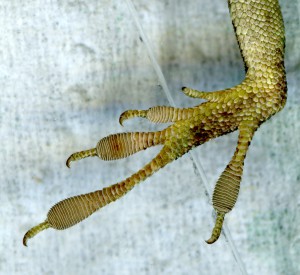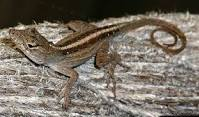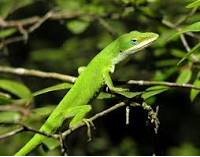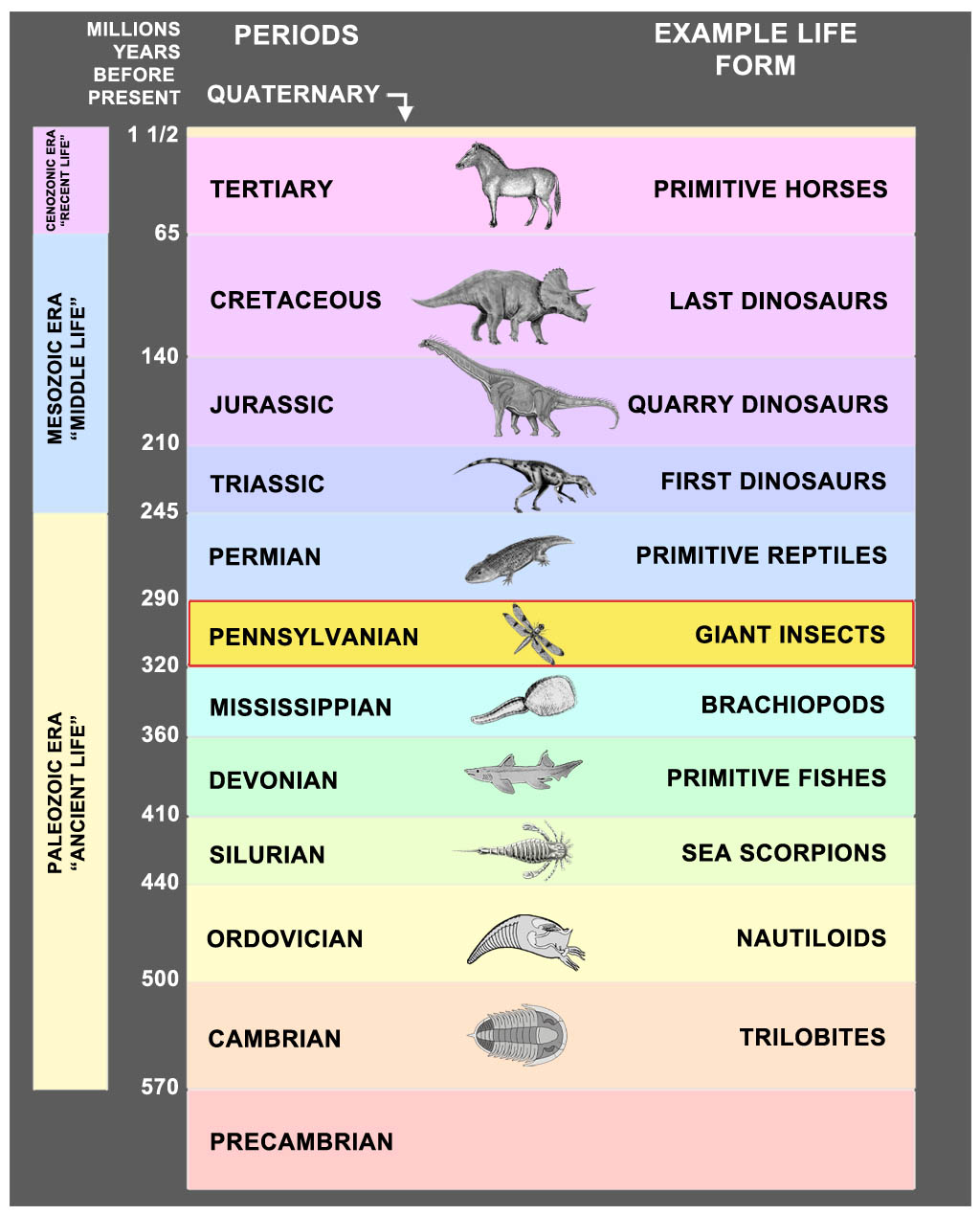It looks like you're using an Ad Blocker.
Please white-list or disable AboveTopSecret.com in your ad-blocking tool.
Thank you.
Some features of ATS will be disabled while you continue to use an ad-blocker.
share:
utexas.edu

And an abstract of the paper: sciencemag.org
Pretty neat that it's happening at such a quick pace, lucky for the lizards too!
AUSTIN, Texas — Scientists working on islands in Florida have documented the rapid evolution of a native lizard species — in as little as 15 years — as a result of pressure from an invading lizard species, introduced from Cuba.
After contact with the invasive species, the native lizards began perching higher in trees, and, generation after generation, their feet evolved to become better at gripping the thinner, smoother branches found higher up.
The change occurred at an astonishing pace: Within a few months, native lizards had begun shifting to higher perches, and over the course of 15 years and 20 generations, their toe pads had become larger, with more sticky scales on their feet.
"We did predict that we'd see a change, but the degree and quickness with which they evolved was surprising," said Yoel Stuart, a postdoctoral researcher in the College of Natural Sciences at The University of Texas at Austin and lead author of the study appearing in the Oct. 24 edition of the journal Science.

And an abstract of the paper: sciencemag.org
In recent years, biologists have increasingly recognized that evolutionary change can occur rapidly when natural selection is strong; thus, real-time studies of evolution can be used to test classic evolutionary hypotheses directly. One such hypothesis is that negative interactions between closely related species can drive phenotypic divergence. Such divergence is thought to be ubiquitous, though well-documented cases are surprisingly rare.
On small islands in Florida, we found that the lizard Anolis carolinensis moved to higher perches following invasion by Anolis sagrei and, in response, adaptively evolved larger toepads after only 20 generations. These results illustrate that interspecific interactions between closely related species can drive evolutionary change on observable time scales.
Pretty neat that it's happening at such a quick pace, lucky for the lizards too!
edit on 25-10-2014 by Elton because: Added foot.
That's about the only thing evolving here in florida, oh and the black market drug trade, that's always evolving.
Let's hope these guys take the whole evolving thing at a slower pace. They are playing with a stacked deck as it is.
voices.nationalgeographic.com...
voices.nationalgeographic.com...
I was just discussing this on FB. Is it micro-evolution? Is it adaptation? I personally lean towards the latter.
originally posted by: intrepid
I was just discussing this on FB. Is it micro-evolution? Is it adaptation? I personally lean towards the latter.
I would say it's evolution - survival of the fittest. Random mutations led to larger toe-pads so the anole's that could get higher survived and the others did not. The genes of larger toe-pad anole's became dominant...that is evolution.
In the last fifteen years those lizards have generated a lot of money off of old people in Florida selling hearing aids.
Oh, maybe I am a little off topic
Oh, maybe I am a little off topic
a reply to: Gully
Just not seeing it as evolution. It doesn't work that way. Look at us 20 generations ago. That would be what? 500 years? Still the same species. We're taller, live longer, etc but really still the same. The buggers I'm really worried about are the cats. In about 2 million years that dew claw will become a thumb and they will take over. Not a big whoop as we will be LONG gone.
Just not seeing it as evolution. It doesn't work that way. Look at us 20 generations ago. That would be what? 500 years? Still the same species. We're taller, live longer, etc but really still the same. The buggers I'm really worried about are the cats. In about 2 million years that dew claw will become a thumb and they will take over. Not a big whoop as we will be LONG gone.
Sort of makes you wonder perhaps if there is something else at play rather than solely the fittest of each generation survives to create offspring,
since this adaptation has happened pretty fast to make such a large change. Such as lets say on the first generation, it has to use certain muscles
much more than it's normally accustomed to, that even the increased utilization might factor into what is passed on to offspring. Maybe, maybe not,
but it wouldn't seem impossible...and evolutionarily, that would be better than just random mutations and the fittest among that survive. A creature
that could do that, would certainly have an advantage.
edit on 10/25/2014 by Turq1 because: (no reason given)
originally posted by: intrepid
a reply to: Gully
Just not seeing it as evolution. It doesn't work that way. Look at us 20 generations ago. That would be what? 500 years? Still the same species. We're taller, live longer, etc but really still the same. The buggers I'm really worried about are the cats. In about 2 million years that dew claw will become a thumb and they will take over. Not a big whoop as we will be LONG gone.
Raccoons, squirrels, and possums have a head start on cats. They already have the thumbs.
Possums have a long way to go in the brains department, but coons and squirrels worry me...coons especially.
I'm inclined to believe this is an adaptation. It sounds like increased muscular strength enherited by offspring. It's similar to atrophy: use it or
lose it. Is there a peer review out yet?
edit on 25-10-2014 by gorsestar because: (no reason given)
a reply to: skunkape23
They just don't have the "nasty". Ever see how cute a cat is when it's ripping the throat out of something?
They just don't have the "nasty". Ever see how cute a cat is when it's ripping the throat out of something?
originally posted by: intrepid
a reply to: skunkape23
They just don't have the "nasty". Ever see how cute a cat is when it's ripping the throat out of something?
Ever seen the aftermath of a coon versus a cat. I had to amputate a cat's tail after it tangled with a coon.
It was just vertabrae. The hide and muscle had been pulled off like a sock.
He also lost an ear, an eye, and half of one foot.
Coons don't play.
When you really think about it IF this is accurate,then REPTILES should have evolved BEFORE mammals as a sentient race.
originally posted by: cavtrooper7
When you really think about it IF this is accurate,then REPTILES should have evolved BEFORE mammals as a sentient race.
According to popular theory they were the dominant species for millions of years and then became birds. I'm REALLY compressing a pantload of time in that.
As an ex Floridian who grew up around these lizards as well as raised both, it's good to see that they are adapting.
For images:
Brown Anoles (Anolis sagrei)

Eat the Green Anoles (Anolis carolinensis)

For images:
Brown Anoles (Anolis sagrei)

Eat the Green Anoles (Anolis carolinensis)

originally posted by: cavtrooper7
When you really think about it IF this is accurate,then REPTILES should have evolved BEFORE mammals as a sentient race.
Well they did it was called the Mesozoic era. Before the permian extinction many creature had reptilian and mammal like qualities.
It wasn't a straight up race of what could evolve first the environment was the main driver. During the permian extinction air quality dropped the point where almost every creature bigger than a meerkat died off. During the triassic period it looks as though lizard qualities were able to outcompete mamalin qualities maybe because they could evolve faster and bigger. There is a lot to it even what I said is compressed time scale.

new topics
-
Former Labour minister Frank Field dies aged 81
People: 27 minutes ago -
SETI chief says US has no evidence for alien technology. 'And we never have'
Aliens and UFOs: 2 hours ago -
This is our Story
General Entertainment: 4 hours ago -
President BIDEN Vows to Make Americans Pay More Federal Taxes in 2025 - Political Suicide.
2024 Elections: 7 hours ago -
Ode to Artemis
General Chit Chat: 7 hours ago -
Ditching physical money
History: 11 hours ago -
One Flame Throwing Robot Dog for Christmas Please!
Weaponry: 11 hours ago -
Don't take advantage of people just because it seems easy it will backfire
Rant: 11 hours ago
top topics
-
University student disciplined after saying veganism is wrong and gender fluidity is stupid
Education and Media: 15 hours ago, 14 flags -
President BIDEN Vows to Make Americans Pay More Federal Taxes in 2025 - Political Suicide.
2024 Elections: 7 hours ago, 10 flags -
One Flame Throwing Robot Dog for Christmas Please!
Weaponry: 11 hours ago, 6 flags -
Should Biden Replace Harris With AOC On the 2024 Democrat Ticket?
2024 Elections: 13 hours ago, 6 flags -
SETI chief says US has no evidence for alien technology. 'And we never have'
Aliens and UFOs: 2 hours ago, 4 flags -
Don't take advantage of people just because it seems easy it will backfire
Rant: 11 hours ago, 4 flags -
Ditching physical money
History: 11 hours ago, 4 flags -
Ode to Artemis
General Chit Chat: 7 hours ago, 3 flags -
God lived as a Devil Dog.
Short Stories: 17 hours ago, 3 flags -
VirginOfGrand says hello
Introductions: 12 hours ago, 2 flags
active topics
-
British TV Presenter Refuses To Use Guest's Preferred Pronouns
Education and Media • 133 • : KrustyKrab -
Breaking Baltimore, ship brings down bridge, mass casualties
Other Current Events • 472 • : Justoneman -
Election Year 2024 - Interesting Election-Related Tidbits as They Happen.
2024 Elections • 69 • : Threadbarer -
Former Labour minister Frank Field dies aged 81
People • 2 • : Freeborn -
Terrifying Encounters With The Black Eyed Kids
Paranormal Studies • 72 • : Consvoli -
The Superstition of Full Moons Filling Hospitals Turns Out To Be True!
Medical Issues & Conspiracies • 24 • : angelchemuel -
SETI chief says US has no evidence for alien technology. 'And we never have'
Aliens and UFOs • 13 • : andy06shake -
"We're All Hamas" Heard at Columbia University Protests
Social Issues and Civil Unrest • 266 • : KrustyKrab -
Russia Ukraine Update Thread - part 3
World War Three • 5720 • : Freeborn -
University student disciplined after saying veganism is wrong and gender fluidity is stupid
Education and Media • 32 • : BedevereTheWise

